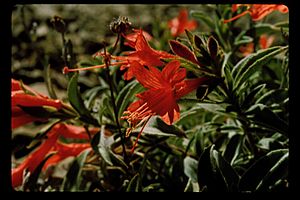Epilobium septentrionale facts for kids
Quick facts for kids Epilobium septentrionale |
|
|---|---|
 |
|
| Scientific classification | |
| Genus: |
Epilobium
|
| Species: |
septentrionale
|
| Synonyms | |
|
Zauschneria septentrionalis |
|
The Humboldt County fuchsia (scientific name: Epilobium septentrionale) is a special type of plant. It is also known as the northern willowherb. This plant is part of the willowherb family.
For a long time, scientists thought this plant belonged to a different group called Zauschneria. That group includes the well-known California fuchsia. But after more study, they found it was actually a willowherb. So, they moved it to the Epilobium genus.
Where It Lives
This plant is very unique because it only grows in one place. It is found only in Northern California. When a plant or animal lives only in one specific area, it is called endemic.
The Humboldt County fuchsia is not very common. It likes to grow on rocky ledges. You can find it in the Northern Outer California Coast Ranges. It often grows in small patches of soil between the rocks.
What It Looks Like
The Humboldt County fuchsia is a small, clumpy plant. It grows year after year, which means it is a perennial. It sends up a few straight stems from its base.
Its leaves are shaped like ovals with pointed tips. They feel a bit sticky because they have tiny glands. The leaves are also covered in soft, white fuzz.
Flowers and Pollination
At the end of each stem, you will find a bright flower. These flowers are a beautiful red-orange color. They are shaped like tubes and are about 2 to 3 centimeters long.
Inside the flower, you can clearly see a bunch of stamens. These are the parts that make pollen. There is also one long pistil, which is the female part of the flower. These parts stick out from the flower's opening.
Birds that drink nectar, like hummingbirds, help pollinate these flowers. They visit the flowers to drink the sweet nectar. As they do, they carry pollen from one flower to another. This helps the plant make seeds.
Fruit and Seeds
After the flower is pollinated, it forms a fruit. The fruit is a long, thin capsule. It is about two centimeters long and covered in tiny hairs. Inside this capsule are the plant's seeds.

